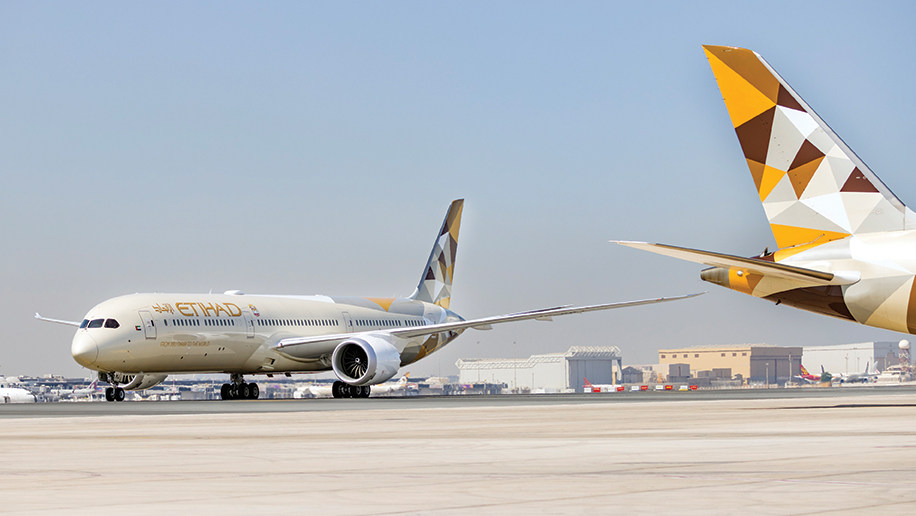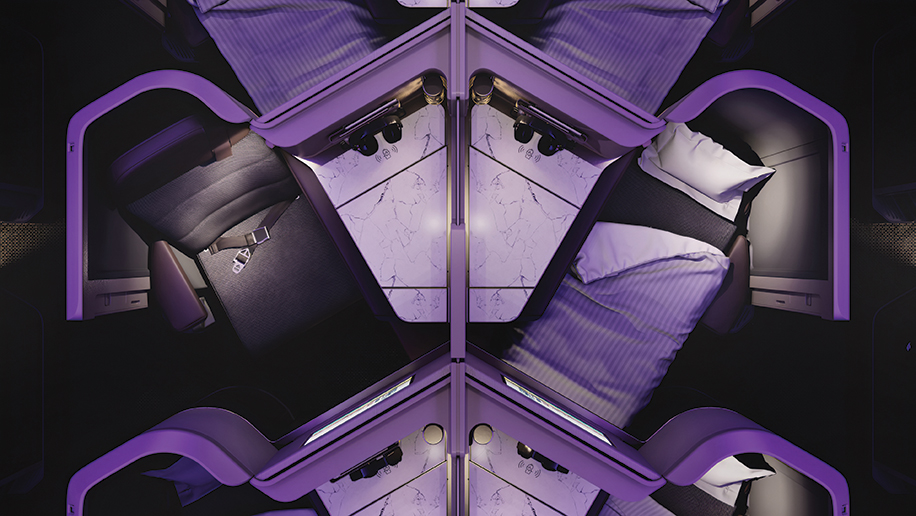
Twenty years ago, an Airbus A330-200 took off for a ceremonial flight from Abu Dhabi International airport flying over all seven emirates of the UAE before landing in Al Ain. That flight marked the inauguration of a brand-new airline. A few days later, Etihad Airways began commercial services by operating two of those aircraft. Its first international flight took place from Abu Dhabi to Beirut on November 12. Over the last two decades, the national airline of the UAE has come a very long way. “In terms of passenger numbers, this year we expect to serve more than 13 million passengers, an increase from 10 million last year. We’re on a journey to expand over the next seven years and have a roadmap to fly 30 million passengers a year by 2030,” Antonoaldo Neves, the chief executive officer of Etihad Airways, told Business Traveller Middle East.
Neves was appointed to the top role at Etihad in October last year, replacing Tony Douglas who departed to lead Riyadh Air. Neves is an aviation industry veteran having previously served as the CEO of TAP, Portugal’s national carrier, and also as president of Azul Airlines in Brazil which he guided to an IPO on the New York Stock Exchange. Formerly, as a partner at McKinsey & Company, he was also involved in strategising long-term planning for Brazil’s aviation sector.

Joining Etihad at a time when Abu Dhabi had nearly lifted all its Covd-19-restrictions, accompanied by the concurrent surge in demand for global air travel towards the end of last year, Neves was forced to hit the ground running. “I have learned from my experience at all the airlines I have worked for that meeting and exceeding the requirements of stakeholders will always lead to success. Etihad is now in a place where it is growing to meet the demands of our customers and of Abu Dhabi. We are making sure our network, our frequencies and our infrastructure are tailored to meet their needs,” says Neves.
Neves adds that the airline is currently flying to more than 70 destinations, and it has this year alone announced 11 new destinations including Copenhagen, Dusseldorf and Osaka.
By March 31 next year, it will operate four-time-weekly services to Boston. It will be the carrier’s fourth destination in the United States – the others being Chicago, New York and Washington. A major draw of flying to the US with Etihad is that passengers can clear US immigration in Abu Dhabi itself before boarding their flight – Abu Dhabi is the only airport within the Middle East to offer such a facility, and is one of only 15 US Customs and Border Protection (CBP) Preclearance locations worldwide.
Neves outlines where the next phase of its network growth will likely stem from. “Already this year, we’ve announced we’re going double daily on many of our routes. For growth, we’re primarily focused on connecting short to medium routes with medium to long-haul destinations – so, for example, connecting Asian markets such as India, with European cities such as London, Paris or Frankfurt.
“As people from China travel more, it is perhaps more a key market for opportunity now than it ever was. We have a strong relationship with India and that’s an important and growing market for us too.”
China and India are major markets for the carrier. This year marked the 15th anniversary of the airline’s flights to China and Beijing. In March, it started operating to Beijing Daxing International airport having previously operated to Beijing Capital International airport.
India, meanwhile, with a domestic population to match that of China, has an aviation sector that is rapidly expanding too. Historically, it has been deeply connected to destinations in the GCC. Currently, Etihad flies to eight cities in India. Not surprising then that the carrier appointed Bollywood actor Katrina Kaif as its ambassador in September.

Etihad is also diligently growing its fleet in tandem with its network. In June last year, it introduced the A350-1000 to its fleet, one of five that are now present within its portfolio. This year, it began the process of reinstating four A380s into its fleet to meet demand. “While we launch new destinations, we’ve also added aircraft to our fleet, with the A380s returning on our routes to London. We’ve also just taken delivery of a brand-new 787-10 fresh out of the Boeing factory in Charleston in the US. We have a further three 787-9s due to be delivered this year, and these feature our new business class cabin. This year we’ve expanded the fleet by 15 additional aircraft,” observes Neves.
The new Business Studio was first showcased on Etihad’s A350 last year, and this year’s Dreamliner deliveries feature an enhanced version of it. Each of the business seats has direct aisle access. “This cabin interior takes the inflight experience to the next level for our guests. Our guests in business class will enjoy an increased level of privacy, space and comfort in a beautifully designed cabin.” Part of elevating that inflight experience also meant that earlier this year, Etihad launched free and unlimited inflight social media messaging access across its entire widebody fleet.
To accommodate the increasing number of aircraft it is acquiring, it has also this month shifted its base to the sprawling new state-of-the-art Terminal A at Abu Dhabi International. Etihad will be among a total of 28 airlines that will begin operating at Terminal A this month. “This move to Terminal A is a key facilitator in our growth plans, providing us with the space to accommodate additional passengers and aircraft. The new Terminal A is an architecturally stunning building and we’re really looking forward to operating out of our new home. There is going to be an excellent passenger experience for our guests, which is borne from deploying the latest technologies, such as our self-bag drop facilities. We also have kerbside drop off and dedicated check in and security facilities for our guests travelling in premium cabins,” says Neves. The terminal, once fully operational, will be able to accommodate up to 45 million passengers annually.
To achieve its growth targets, Etihad isn’t looking to fly solo. Neves who has worked within the framework of the EU and South American aviation sectors is conscious of what striking the right codeshare and interlines could mean for any airline. Etihad signed an MoU with Air France-KLM Group earlier this year to expand its existing interline and codeshare agreements with them. More than 40 new routes across Europe, Australia, the Middle East and Asia Pacific instantly opened for booking for flights as early as this year itself. By way of the MoU, the entities explored the ideas of cooperating further on their loyalty programmes, ground handling processes, reciprocal lounge access and terminal co-location – all necessary to build an integrated and cost-efficient operational model for each of them.

Under Neves, another major partnership was struck this May when Etihad and Emirates reached an interline agreement. The ‘open jaw’ arrangement allows customers of either airline to purchase a single ticket to fly into either Dubai or Abu Dhabi, and return via the other airport. “Forging strong partnerships with the right airlines will continue to be important as we grow. We’re excited to be partnering with Emirates to bring more guests into the UAE to visit both Abu Dhabi and Dubai – our teams are working together on launching this,” says Neves.
That deal is reportedly the first of its kind between two UAE carriers and was almost necessary when you consider that high-profile airlines including Riyadh Air and NEOM Airlines are planning their own debuts and will join other major players from the region including SAUDIA and Qatar Airways. “The ecosystem of the Middle East aviation sector is strong and growing and, from the customer’s perspective, that can only be a good thing. We respect our peers, of course, but we are focused on what Etihad has to offer. That means a continued focus on quality and ensuring we have a network and frequency allowing our guests to visit Abu Dhabi and global destinations as seamlessly as possible.”
As the national airline of the UAE, Etihad is aware of its environmental responsibilities and has already pledged to achieve net zero carbon emissions by 2050. To get there, it is striving to reduce its emissions intensity by 50 per cent by 2035, with 2019 as its baseline year. “One achievement we’re particularly proud of is reducing CO2 emissions per Revenue Tonne Kilometre by 26 per cent to 482g compared to the 2019 baseline.
“Another example from our guest experience this year was when we introduced new dining equipment in our economy cabins which not only improves the guest experience, but also removes single-use plastic waste. The new dining ware is part of a smart closed loop recycling system – when the products are too old for use on board, they are cleaned, ground down and the powder used to make new replacement products.” Last year, Etihad operated its first flight using sustainable fuel supplied by Neste and ITOCHU Corporation for a service from Tokyo Narita to Abu Dhabi. Neves points out that Etihad has also been working with Satavia on contrail avoidance research and technology to support the reduction of climate impact for the entire industry.
It’s been just over a year since Neves took the reins at Etihad and there have already been several successful aircraft deliveries including the A350s and Dreamliners, a revamp of its cabin offering on key aircraft, and a robust network expansion. What’s next on Neves’ roster? “We’re celebrating our 20th anniversary, a pivotal moment for us. As we roll out Etihad’s Journey 2030 strategy, we have a very clear roadmap of our priorities. We’re focused on building a strong network which makes it convenient for our guests to travel across the world as well as bringing them to Abu Dhabi.”












